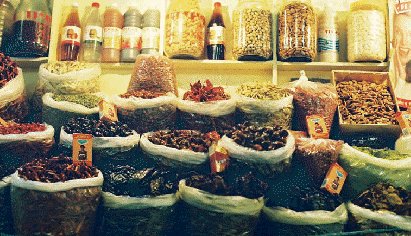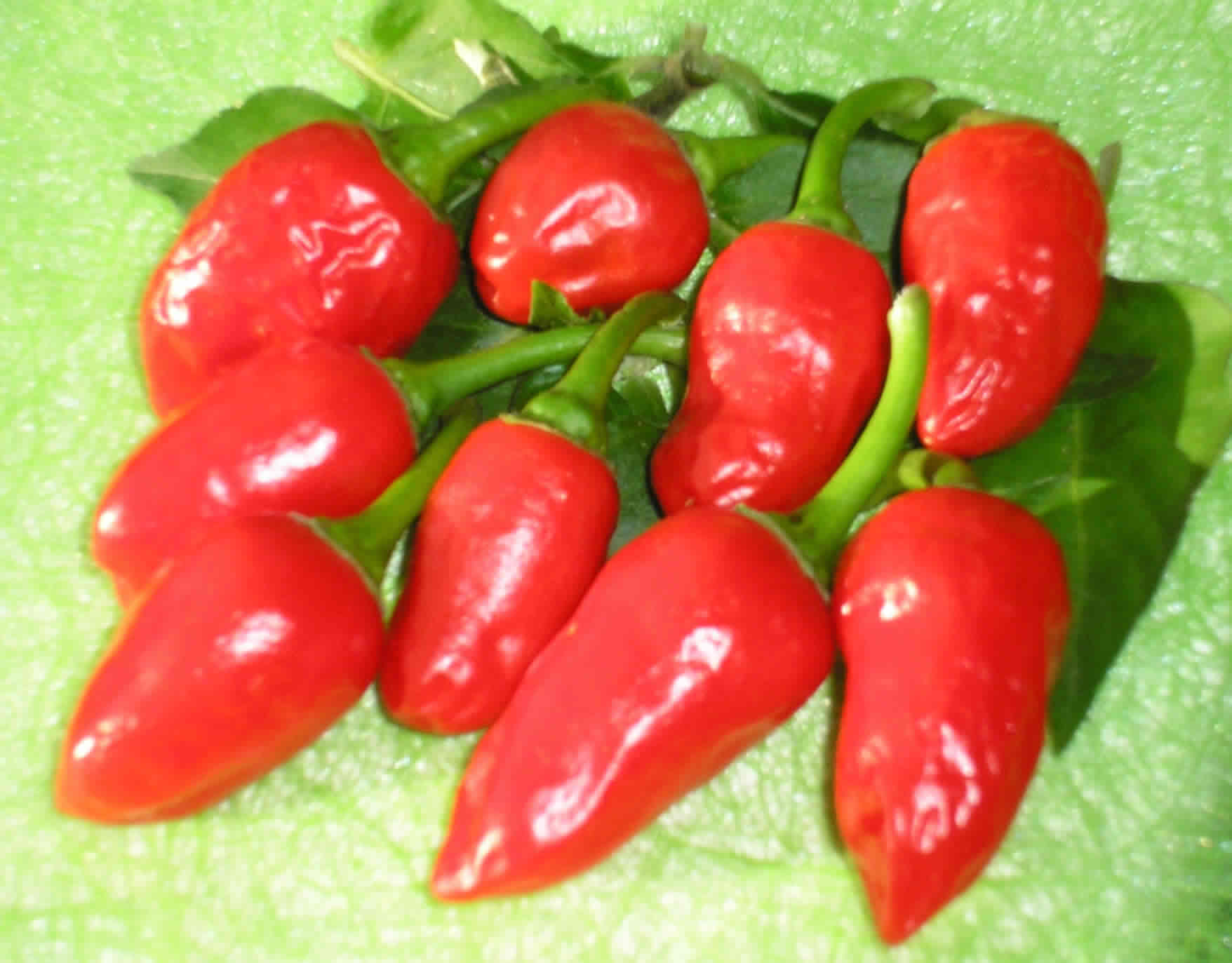THE world’s hottest chilli pepper does not come from a tropical hot spot where the locals are impervious to its fiery heat but a smallholding in deepest Dorset.
Some chillis are fierce enough to make your eyes water. Anyone foolhardy enough to eat a whole Dorset Naga would almost certainly require hospital treatment.
The pepper, almost twice as hot as the previous record- holder, was grown by Joy and Michael Michaud in a poly- tunnel at their market garden. The couple run a business called Peppers by Post and spent four years developing the Dorset Naga.
They knew the 2cm-long specimens were hot because they had to wear gloves and remove the seeds outdoors when preparing them for drying, but had no idea they had grown a record-breaker.
Some customers complained the peppers were so fiery that even half a small one would make a curry too hot to eat. Others loved them and the Michauds sold a quarter of a million Dorset Nagas last year. At the end of last season Mrs Michaud sent a sample to a laboratory in America out of curiosity. The owner had never tested anything like it.
According to Mrs Michaud, the hottest habañero peppers popular in chilli-eating competitions in the US generally measure about 100,000 units on the standard Scoville scale, named after its inventor, Wilbur Scoville, who developed it in 1912. At first the scale was a subjective taste test but it later developed into the measure of capsaicinoids present. The hottest chilli pepper in The Guinness Book of Records is a Red Savina habañero with a rating of 570,000 Scoville Heat Units (SHU).
Mrs Michaud was stunned when the Dorset Naga gave a reading of nearly 900,000SHU. A fresh sample was sent to a lab in New York used by the American Spice Trade Association and recorded a mouth-numbing 923,000SHUs.
Mrs Michaud said: “The man in the first lab was so excited — he’d never had one even half as hot as that. The second lab took a long time because they were checking it carefully as it was so outrageously high.”
The Dorset Naga was grown from a plant that originated in Bangladesh. The Michauds bought their original plant in an oriental store in Bournemouth. Mrs Michaud said: “We weren’t even selecting the peppers for hotness but for shape and flavour. There is an element of machismo in peppers that we aren’t really interested in. When the results of the heat tests came back I was gobsmacked.”
The couple are now seeking Plant Variety Protection from the Department for Environment, Food and Rural Affairs, which will mean that no one else can sell the seeds.
Mrs Michaud, 48, has run the company with her husband at West Bexington, near Dorchester, for ten years. Mr Michaud, 56, has been a regular on the television chef Hugh Fearnley-Whittingstall’s River Cottage series, advising on vegetable growing.
Anyone wanting to try the Dorset Naga will have to be patient as chillis are harvested only from July on. In Bangladesh the chillies grow in temperatures of well over 100F (38C) but in Dorset they thrive in polytunnels.
Aktar Miha, from the Indus Bangladeshi restaurant in Bournemouth, said that even in its home country the naga chilli was treated with respect. “It is used in some cooking, mainly with fish curries, but most people don’t cook with it. They hold it by the stalk and just touch their food with it,” he said.
“It has a refreshing smell and a very good taste but you don’t want too much of it. It is a killer chilli and you have to be careful and wash your hands and the cutting board. If you don’t know what you are doing it could blow your head off.”
FROM HOT TO NOT
Scoville Heat Units
Pure capsaicin: 15m to 16m
US Police-grade pepper spray: 5m
Dorset Naga: 923,000
Red Savina habanero: 577,000
Scotch bonnet: 100,000-325,000
Jamaican hot pepper: 100,000-200,000
Cayenne pepper: 30,000-50,000
Jalapeno pepper: 2,500-8,000
Tabasco sauce: 2,500
Pimento: 100 to 500
Bell pepper: 0
----------------------------------------
Chili Peppers: history, facts, and tips…
The chili pepper, a hotly pungent variety of Capsicum was first cultivated by the people of Central and South America in around 3000BC. Columbus brought seeds back to Europe in 1493, and from there it has spread to the cuisines of the entire world. The pre-Hispanic Americans believed the chilli to contain medicinal qualities and modern science has confirmed the nutritional values, containing high levels of vitamins A and C, along with vitamins E and B1-3. (spelling of chili can be with one or two letter "l"s.)

A Chili stall - Mexico City -
Natural diversification and biotechnology have produced hundreds of varieties, differing greatly in hotness, size shape, and ranging in colours from orange to red to yellow to green. They can be eaten fresh, pickled, or preserved by drying in the sun. Perhaps the world's most famous chilli is the Jalapeño, the stubby green variety from the city of Jalapa, on Mexico's gulf coast. The Chilpotle chilli is a dried and smoked Jalapeño that is spicier than the green version and usually available in a pickled form. Other famous varieties of chilli include the extremely hot Habenero (or scotch bonnet), the birds-eye, the Thai, and the tiny Pequin, which is the fiery base for Tabasco sauce.
What is the hottest chilli? According to the Guinness Book of Records it is the Red Savina pepper (a Habanyera cultivar). It was tested at 577,000 SHU. Since then there have been two credible claims of hotter chillis. see the News flashes below. Both of the varieties described are Naga chillies originating from the North West of India. They both seem to be Capsicum Chinense, which is also the species that produced the Habanero. The foothills of the Himalayas also produces a smallish pumpkin shaped, orange variety that is reported to be as hot or hotter than the Nagas. Some of the local peoples refer to it as the Sikkimese Cherry Chilli.
Should we spell the word Chile or Chilli or should it have just one 'l' - Chili? It seems to be entirely up to you! Did you notice the different spellings in this article?
Tips for cooking
-
As a rule red fresh fruit are two or three times hotter than green fruit, and dried pods are up to ten times hotter than fresh pods.
-
The seeds and white pith of a chilli are the hottest part, so remove them if you don't want your dish to be too fiery.
-
Chillies contain a pungent oil that can cause an unpleasant burning sensation to eyes and skin. Try to avoid handling them too much, wear gloves if possible, and be sure not to touch your face or eyes during preparation.
-
As a general guide the smaller the chilli the hotter it will be.
-
Soaking a chilli in vinegar has the effect of distributing the hot chilli flavour through the dish. Discarding the vinegar and soaking again has the effect of further reducing the heat.
Varieties
Some of the varieties of hot chillies:-
Aci Sivri, Aji Brown, Aji, Almapaprika, Anaheim, Ancho, Asain, Azr, Bahamian, BigJim, Birds Eye, Cabai Burong, Carolina Cayenne, Cascabel, Cayenne, Cheiro, Cherry, Chile de Arbol, Chiltecpin, Chiltepin Cherry, Chiltepin, Chimayo, Chipolte, Chipotle, Cobanero Mayan Love, Cobra, Coronado, Dagger pod, Demre, El Paso, Espanola, Guajillo, Habanero, Haimen, Hidalgo, Hot Wax, Hungarian Hot Wax, Hungarian, Jalapeno, Jaloro, Jamaican Hot, Japones, Kumataka, Lavingya, Manzano, Merah, Mexican Negro, Mirasol, Mulato, New Mexican, Naga, Nu Mex BigJim, Pasilla, Pepperoncini, Pequin, Piquin, Poblano, Pulla, Punjab, Pusa Jwalla, Putario, Puya, Red Savina Habanero, Rocoto, Rocotillo, Rocoto, Rojo, Sandia, Santa Fe Grande, Santaka, Santo Domingo Pueblo, Scotch Bonnet, Serrano, Serrano, Shipkas, Sikkimese Cherry Chili, Super Chile, Tabasco, Tabiche, Tepin, Tepîn, Tezpur, Thai, Trupti, Yatsafusa, Yellow, Yellow Wax, Zimbabwe Bird
The following can sometimes be mildly hot; Sweet Banana, Sweet Bells
How is hotness measured? The unit of hotness is the SHU or Scoville Hotness Scale. Wilbur Scoville was an eminent American chemist. He devised a test based on repetitively diluting an extract of the pepper with sugar water until the heat is no longer detected. Testing is now more usually performed using accurate laboratory equipment, namely a chromatograph, and equating 15 parts per million (PPM) of capsiacin with an increase of 1 on the Scoville scale.
News Flash#4!!
Tesco, the British owned supermarket giant has put some of the Dorset Naga (see below) on their shelves in nothern Englisg stores. Lets see if they can keep selling it without being sued?
News Flash#3!!
November 2006; Dr David Julius working at the University of California in San Francisco has made a very interesting discoveries linking the active ingredient from chillies and a component of tarantula venom. One of the non-toxic substances found in the fluid injected during a tarantula bite is almost identical to capsiacin and works in exactly the same way.
News Flash#2!!
Dorset England;.Michael and Joy Michaud who run a company supplying chilli sauces and chillis by mail order. They purchased a Bangladeshi chilli from a local market and bred the new one from the seeds. Laboratory tests yielded results of 876,000 and 970,000 SHUs. April 2006
News Flash#1!!
Tezpur, Assam is home to the hottest chilli in the world, the Naga Jolokia is smallish and green and rated at 800,000 plus on the Scoville scale. Now that is military or chemical warfare hot !!! June 2004
Related Spices: The hot spices work by fooling the body into experiencing pain. This is achieved by the active chemical fitting in to a type of mammalian pain receptor - the nociceptor.
Black Pepper: The hotness in pepper comes from the active ingredient Piperine, Chemical formula: C17H19NO3, Peppercorns are the seeds of the Asian vine Piper Nigrum, one of our most common spices. Threshold of taste is approximately 700ppm. Compare with Capciacin the active ingredient in chillies - 10ppm.
Ginger: A rhizome from the ginger plant Zingiber Officinale. Zingerone, is the hot ingredient. It has several components to its taste and is reputed to have medicinal properties. The threshold of sensation with ginger is considerably more even than black pepper.

A Himalayan variety -
Kalimpong Fire Drops
Why Hot??? It seems that for the chilli plant to propagate it is best if birds, rather than mammals carry the seeds, the pain receptors that respond to capsaicin are missing in birds, hence the birds do not experience the discomfort that we and other mammals do. Isn't nature smart. The scientific explanation is that capsaicin acts on a specific molecule on the surface of the pain sensing nerve fibres found in mammals causing a sensation of pain.
Why do we love the pain?? A credible explanation put forward is that the pain caused by the capsaicin causes endorphins to be generated in the body, these are the "pleasure chemicals". The endorphins seem to last longer than the pain sensation so we remember the last sensation and tend to forget the former. Any other explanations would be welcome.
Chillies have been recommended by some as having properties that can be used to treat long term and chronic pain, now scientists are developed a more targeted treatment using the capsiacin from chillies and the common pain killer lidocaine in combination. It is thought that the chilli extract opens up the receptors and allows in the anaesthetic. The big advantage over existing local anaesthetics is that if they are right they have found a local anaesthetic that does not have the usual side-effects oc making the patient sluggish and slow-witted and allow more muscle control so that no longer would one have a 'frozen' face after a trip to the dentist. The scientist who carried out the research, Binshtok AM, Bean BP and Woolf, are from Massachusetts General Hospital and Harvard Medical School




